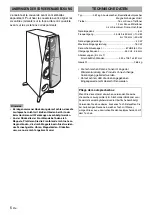
3
En
This speaker is capable of standard connections and bi-wired connections. Before making connections,
make sure that the amplifier is switched off.
■
CONNECTIONS
You need a commercially available speaker cable.
y
The size and/or material of a speaker cable affects on the
sound quality. Therefore, we recommend you to purchase a
high-quality speaker cable to exert the performance of this
unit.
• Connect the screw-type terminals at the rear of the
speakers to the speaker terminals on the amplifier with
a speaker cable (sold separately).
• Connect the (+) terminals on the amplifier and the
speakers using one side of the cable. Connect the (–)
terminals on both components using the other side of
the cable.
• Connect one speaker to the left (L) terminals of your
amplifier, and another speaker to the right (R) terminals,
making sure not to reverse the polarity (+, –). If one
speaker is connected with reversed polarity, the sound
will be unnatural and lack bass.
How to connect the cables:
1
Loosen the knob.
2
Remove the insulation coating at the extremity of each
speaker cable by twisting the coating off.
3
Insert the bare wire into the hole.
4
Tighten the knob and secure the cable.
Test the firmness of the connection by pulling the cable
lightly at the terminal.
• Do not let the bare speaker wires touch each other as
this could damage the speaker and/or the amplifier.
• Do not insert the insulation coating into the hole.
The sound may not be produced.
<Standard connections>
When connecting the speaker cable, leave the jumper
cables in place.
*
The terminal hole is 5 mm (3/16”) in diameter.
CONNECTING TO YOUR AMPLIFIER
Notes
Good
No Good
10 mm
(3/8”)
Tighten
Loosen
Insulation coating
Bare wire
Soavo-3 (R)
Soavo-3 (L)
Amplifier
Speaker
terminals of
the amplifier
Jumper cable
Connect the + speaker cable to
the upper red terminal and then
– speaker cable to the lower
black terminal.
Black (–)
Terminal hole
*
Red (+)





































